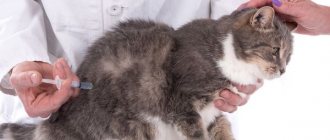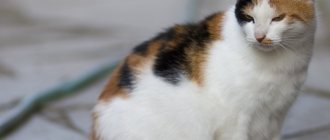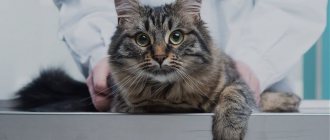Basic Rules
When choosing a place where the cat will give birth and the kittens will spend the first weeks of their lives, it is important to adhere to the following rules:
- It should be warm and protected from drafts.
- Definitely safe and comfortable. It is very important to equip the maternity area where no one can accidentally step on the babies.
- Must be quiet and in a dark place.
- It is best to choose natural fabrics and materials.
- The design should be such as to enable the owner to do cleaning without disturbing the animals.
In this case, both the mustachioed mother and the kids will be comfortable. The place for childbirth should be prepared in advance, this will help accustom the animal to its new “house”.
Building a cat house
There are also certain requirements for the “room” in which the cat will give birth and the newborn kittens will be kept for the first time. A box of household appliances and an old rag at the bottom is not exactly what you need. If you decide to build a cat house yourself or order it from a master according to your design, then the house should be comfortable, practical, durable and safe. Let's consider “maternity hospitals” of different designs and from different materials.
House made of cardboard boxes
Cardboard boxes are the most budget-friendly option for animal den material. Even if we build a house from available materials, it must be durable and comfortable. We choose a large box - at least 50x50x50 in width, height and length, respectively. After all, a cat with kittens will need a lot of space. The cat not only needs to give birth, but also raise kittens for a month.
There needs to be enough space to prevent the cat from crushing the newborns. Heating lamps should be aimed at one wall of the room so that the other is cooler, and the animal can move away from the heating source if the temperature is too high.
The box should have a lid on top for free access to the family, in case of need for assistance during childbirth and maintaining cleanliness inside. In one of the side walls you need to make an entrance for the cat with a small threshold so that blind kittens do not crawl out of the box. The hole is cut at the chest level of an adult cat. If the entrance hole is not made, then jumping into the box over the top, a young mother can injure her babies.
The outside of the box needs to be strengthened by additionally gluing the outer edges with paper tape. Some decorate the outside of the house with self-adhesive film or pieces of wallpaper, but in this case the decoration may become unnecessary - a cardboard house is short-lived, the cat may not like the riot of colors, and the smell from the wallpaper or film will irritate the sensitive sense of smell of a small predator. The walls need to be treated in advance - wipe with an odorless disinfectant solution, and then dry the structure.
A layer of absorbent is placed on the bottom - old newspapers, soft natural sheets, preferably light, to make it easier to monitor the cleanliness of the nest, and on top everything is covered with a disposable diaper. They are convenient to change and do not allow moisture to pass down. The fabric used as bedding should not be synthetic, be smooth and sufficiently dense, and hygroscopic. It is unacceptable to use terry or loose fabric, as the kitten can catch its claw on the textured fabric and be injured.
Suitable options
In order for the animal to feel good and not worry too much, the birthing area should be properly prepared in a timely manner. Especially if the cat is pregnant for the first time, an inexperienced owner has to deliver the baby .
- A box for giving birth to a cat is the simplest and most convenient option. At the bottom you need to put something warm and soft, for example, an old sweater, and on it - disposable diapers that are easy to remove and change. Before giving birth, it is advisable to lay a fresh one.
- A cage is also a good option for the birth of kittens. When the kids grow up, it is very easy to wash.
- Box. You can place in it not only soft bedding, but also a feeder, a bowl of water, and if the size allows, even a tray. This way the cat can avoid being away from the babies for a long time.
- Baskets. They are equipped with special mattresses, which can later be washed without any problems. However, this is an open option, so the cat will not feel completely safe.
- Tents. For childbirth, you can also use tents - both exhibition and arched. They are easy to close, so the cat will not be able to constantly carry the kittens from place to place. However, an animal can spill water from a bowl or scatter food, and it is quite difficult to tidy up such a “house” while the kittens are in it.
- Breeders often use playpens as a place for childbirth.
The owner must first of all think about the pet, so it is better to refuse a fashionable and beautiful tent in advance if the animal previously felt uncomfortable in it.
Possible complications during lambing
Complications during lambing can occur at any stage of birth in both mother and kittens.
Complications from the parturient side may be the following:
- ruptures of the birth canal due to hypertension;
- bleeding;
- refusal of kittens - the cat is not interested in newborns and growls if they are placed near her;
- sepsis;
- uterine prolapse;
- retention of placenta;
- acute mastitis – inflammation of the mammary glands;
- cannibalism.
Newborn problems:
- congenital malformations - cleft palate, development of internal organs outside the body;
- intrauterine infections, due to which kittens are stillborn or die in the first few days;
- abnormal position of the fetus - in such cases the cat will not be able to give birth on its own;
- aspiration (inhalation) of amniotic fluid, pneumonia.
Cleft palate in a kitten
How you can help:
- Before mating a cat, it is necessary to thoroughly examine her and the future father of the kittens for the presence of infections and pathologies that are transmitted genetically.
- During pregnancy, transfer the cat to specialized food for pregnant and lactating cats.
- Take an x-ray a week before the expected birth - this way you can accurately find out the number of kittens in order to understand when the birth should end. It is impossible to determine their number by ultrasound.
- Create the most sterile conditions for childbirth.
- Find “your” veterinarian and enlist his support.
A breed such as the Scottish has two variants of the phenotype - fold-eared and straight-eared. And it requires a special approach when breeding.
It is very important that only one of the parents has lop ears. If you cross two fold cats, then 100% of the kittens will be born with joint pathologies and will hardly live to be three years old
These will be disabled animals. This disease is called osteochondroplasia of Scottish fold cats and is associated with a mutation of cartilage tissue.
How to create a place for childbirth
Having noticed that the cat is looking for a place to give birth, the owner must immediately take action and help her. It's best to start preparing early. To do this, take a cardboard box, cut a hole so that the animal can come out of it, and lay a mattress or something soft on the bottom. A disposable clean diaper is placed on top. To make cleaning easier, you need to choose a box that opens from the top.
In order for the animal to feel confident, it is necessary to introduce it to the “house” in advance, and even better, place it in a secluded place where the cat liked to rest.
What does it mean to prepare a place for a cat during birth? First of all, this is the creation of suitable conditions, so if the room is cold, you should place a heating pad in the box or turn on a special lamp. When the cat gives birth, the diaper should be changed.
By preparing the place in advance, before the animal begins to show the first signs of imminent labor, the owner will get rid of many problems. The cat, first of all, will not give birth to babies in the closet, spoiling the things there, and will not experience stress or show anxiety. And the process itself will be easy.
Alarming symptoms
An unqualified owner cannot always help a furry pet. That is why during childbirth you should have the telephone number of the treating veterinarian, or preferably two or three numbers, at hand. Four symptoms are a serious reason to contact a specialist.
Ahead of schedule. Most often, premature birth occurs in a cat due to a frozen pregnancy, non-viability of the offspring, placental abruption, or injury. The stages of labor pass faster already on the 50-55th day, sometimes earlier. Most often, a cat gives birth to dead kittens. The living premature offspring dies in the coming days. It happens that a cat gives birth to just one dead baby prematurely. The rest emerge alive and healthy on time. If your cat gives birth prematurely, have her examined by a specialist to understand further steps. Lack of childbirth. If the pet does not give birth for more than 70 days and if this is not a false “birth” due to an imaginary pregnancy in the cat, then the pregnancy is probably frozen. The cubs most likely died, so it is urgent to save the pet from possible infections and damage to the uterus. Missed birth
It is important to determine when labor is truly over. If the pushing has stopped and the cat is resting, this does not guarantee that all the kittens will come out.
You should observe your mother's behavior. A cat that has not yet given birth reluctantly takes care of the cubs, does not leave the “nest” and does not change position, refuses to drink, and periodically strains. To make sure, you can feel the stomach three to four hours after birth. The elasticity and tension of the muscles indicate that there is still a kitten left in the womb. Discharge. Any colored, pungent-smelling discharge during pregnancy and childbirth is a deviation from the norm. During strong, long contractions (more than an hour) without subsequent labor, blood may flow profusely. In this case, it is also necessary to show the cat to a specialist.
Fetal pathologies do not always depend on the health of the mother and can be inherited from the father. However, the physical and mental condition of the cat affects the successful outcome of the birth.
Therefore, it is important that the pet is healthy before mating. Unfavorable factors for childbirth are old age, obesity, stress, heredity
Even the process of childbirth in a cat, supported by instincts, does not always go smoothly. You should mentally prepare for any outcome. However, do not panic prematurely and do not intervene without reason. Nervousness will be transferred to the pet, and during childbirth she will be confused. Rest assured that everything will go well and the cat will be able to rely on its owner.
Where can you put a cat's "lair"?
How to arrange everything? Place the box or basket in a room where there are no drafts, but at the same time you do not need to place it close to the central heating radiator. This should be a quiet place, not a walk-through place . If necessary, you should be able to completely isolate the room from other pets and children. Be sure to place a litter tray and bowls of food and water near the basket. Of course, food and drink need to be regularly replaced with fresh ones.
Please note that the tray needs to be placed away from the “dining room”, and the filler in it will have to be changed twice as often as usual.
This is due to the fact that in nature, all cats carefully camouflage their lair, and therefore cats are extremely sensitive to “toilet” odors near the place where their kittens are.
Let us repeat once again that the basket must be prepared in advance, immediately accustoming the cat to it. Place your pet in it, pet it, talk to the animal in a calm, confident voice. At the same time, we give one simple but important piece of advice: if you don’t want problems in the near future, be sure to isolate all dark corners, the space under the bathroom, etc. from the “ubiquitous” cat. Otherwise, you will almost certainly have to scoop out newborn kittens from there, or wait until they grow up. Follow your pet with a “tail”: if you see that she is looking for a place to give birth, persistently transfer her to the basket.
Available means
A birthing box can be made from improvised materials and old suitcases, drawers from a chest of drawers or a playpen available in every home. The last option is recognized by breeders as the most successful. A folding playpen with a zippered side entrance can be the perfect place for your cat to give birth. Sidewalls made of durable mesh allow you to keep an eye on your cat, do not tear, are easily disinfected and provide free air flow.
Regardless of what kind of place for childbirth the owner has equipped, it must be kept clean. Do not allow the inside of the “birth nest” to be treated with strong-smelling disinfectants. Rugs, mattresses and diapers are washed only in neutral, odorless detergents. Diapers will have to be changed daily. The main thing is to provide the cat with peace and comfort so that it does not get nervous.
The animal may not share the owner’s delight in the new tent or house. Some cats stubbornly go under the sofa, into an old closet or behind a long curtain near the radiator. You should accustom your pet gradually, starting 2-3 weeks before birth. Some people feed the cat treats in the house so that she gets used to it faster.
Tents are convenient in this regard; noting the approach of childbirth, the owner can lock the cat in the house during his absence. If you carefully study the habits and needs of your cat, you can equip a comfortable and safe place for childbirth in a city apartment, as close as possible to the natural needs and instincts of the animal.
It is necessary to prepare the place for the cat's birth in advance, preferably 2 weeks before the birth. This will provide comfortable conditions for the animal and protect future offspring. The maternity house can be purchased ready-made or made with your own hands. To equip and decorate such a home, you need a small amount of materials and basic skills in working with tools. The main thing is to take into account the size of the cat and leave room for offspring.
What should you always have on hand?
Be sure to prepare all of the following and have all of these things on hand at all times. Remember, you most likely won't have to interfere with the birth process, but if necessary, don't run around the house in a panic. Read about the main problems that some cat owners face, and immediately write down the number of a 24-hour veterinary hospital.
So here's what you should prepare:
- Stock up on paper towels and clean cloths. We highly recommend using cotton or flannel scraps, as newborn kittens hardly get tangled in them. Never put cotton wool or “loose” fabrics in the basket, in which the claws of newborn pets will get stuck. Old onesies and children's shirts are ideal (including as a filler for a basket).
- Notepad and pen. We strongly advise you to record the time of birth of each kitten and record when the placenta is delivered after each baby. In addition, you can also record the cat’s body temperature (if you measure it). In the same notebook, write down the number (or preferably several) of the veterinarian.
- Antiseptic solution. It is easy to make it yourself by preparing a 70% aqueous solution of alcohol. However, alcohol tincture of iodine, vodka or even cologne will work perfectly (but it is not advisable to use it).
- Gauze bandages.
- Unwaxed dental floss.
- Disposable gloves for caring for newborn kittens.
- If your cat has had any problems breastfeeding in the past, be sure to prepare a special formula for newborn kittens, as well as a bottle. Luckily, you probably won't have to use this, but it still wouldn't hurt to have some extra. In any case, you can feed the mixture to older kittens (as complementary food).
- Suture removal kit , including blunt scissors and forceps. You may need all this if you have to tie the umbilical cord yourself.
- Accurate scales for weighing small kittens. They are extremely useful if you doubt the viability of the newborn babies.
Possible complications and procedure
Complications can occur at any stage of labor. All pathologies of cat pregnancy can be diagnosed and solved.
Dystocia (obstructed birth) is classified in origin as maternal and fetal, caused by problems with the cat or intrauterine development of the kittens. It may be caused by obstruction of the birth canal or functional inertia of the uterine muscles.
Obstructive dystocia is caused by a disproportion between the size of the kittens and the maternal birth canal.
Functional dystocia manifests itself in rare and weak contractions of the uterus. For dystocia, radiography and cesarean section are indicated.
Inversion of the gravid uterus and uterine rupture can cause serious consequences in the last stage of pregnancy. When the uterus is torsion, the cat is unable to deliver the fetus or fetuses, as a result of which her condition worsens and the kittens die in the womb. Uterine rupture occurs rapidly, causing the fetuses to fall into the abdominal cavity.
The cause of rupture can also be uterine torsion. Excessive bleeding leads to death in the giving birth cat and her offspring. In these cases, urgent surgical intervention is required.
If a cat cannot give birth to a kitten on her own, she needs help. The half-stuck kitten is wrapped in sterile gauze and gently stretched during each contraction.
It must be remembered that there is always a risk of the kitten drowning in amniotic fluid if the process of separating the placenta and clearing the kitten's airway takes too long. A dead fetus in utero can itself lead to functional or obstructive dystocia.
It happens that the fetus dies in the womb even before labor begins. This occurs as a result of infectious diseases suffered by the cat during pregnancy or intrauterine growth retardation.
The cat's suppression of the natural physical process of birth can cause the kitten to be delayed as it passes through the mother's pelvis. The cat feels physical pain and consciously refuses to try to give birth or waits for outside help, without which the kitten will die.
Kitty
A cat that has become a mother begins to wash the newborn kittens from the amniotic sac with care and diligence. In this situation, human intervention is not required. In situations where the mother cat does not show her maternal instinct or the kitten is not breathing, she needs prompt help. You should imitate the actions of a cat:
- Clear the kitten's nasal passage and mouth of mucus. Any liquid that enters the respiratory tract must be sucked out using special equipment. From available means, you can use a catheter attached to a syringe.
- Cut the kitten's umbilical cord at a distance of 4-5 cm from the belly, cauterize it with iodine or peroxide.
- Stimulation of breathing is provided by stroking the kitten's abdominal cavity. If he is not breathing, the airways are first cleared of mucus. You need to breathe air into the kitten's nose and mouth. You should not inhale a large volume of air - the lungs of a newborn kitten are very tiny.
- Absence of heartbeat is a direct indication for chest compressions. The kitten's chest is squeezed rhythmically with the thumb and forefinger. Pressure on the chest alternates every 10-15 seconds with inhalation of air. Resuscitation actions are carried out within five minutes in the absence of a heartbeat, within 20 minutes in case of a weak heartbeat. An effective way is to use doxapram drops. They are dripped onto the kitten's tongue.
- Provide the kitten with physical contact with its mother or ensure that the room temperature is kept warm. Newborn kittens do not know how to properly regulate their heat exchange.
Childbirth in cats
Childbirth is a natural physiological process, but the owner needs to approach this moment with full responsibility. During this period, the owner becomes an obstetrician, comforter, dietician and nanny for the cat. And all this - at the same time. In this article we will look at the signs, the main stages of the birth process in domestic cats, as well as the basics of obstetric care.
Preparing a place for a cat to give birth, what you need to pack for the birth
The physiology of cats is such that in most cases childbirth is easy, without complications. However, you need to prepare for the birth of babies in advance. Provide your pet with a place to lie where she will feel safe. The place must be protected from drafts. The woman in labor should not be disturbed by children or other pets. Move the tray, feeder and drinker to the bedding area. At the same time, it is important to work proactively so that the woman in labor does not “build a nest” on a closet shelf or in the sofa. Try to let your cat outside as little as possible (this is especially true for those living in private houses).
Prepare a set of tools and materials in advance:
- Box for placing newborn babies.
- Medical sterile gloves.
- Sterile thread.
- A small syringe (to remove mucus from the mouth).
- Cotton buds.
- Antiseptics.
- Clean textiles.
- Surgical scissors.
- Antiseptic ointment (levomekol).
- Vaseline oil.
- Oxytocin is a drug that stimulates labor.
- The drug for dehydration is Ringer's solution.
- Dishes for water.
- Dry mixture (milk replacer).
- Water container.
Sometimes childbirth is accompanied by spontaneous bowel movements, so keep cleaning supplies at the ready. You may only need a clean cloth and a box for the kittens, but you need to be prepared for sudden complications.
How can you tell if your cat is going into labor?
At about 7-9 weeks of pregnancy, kittens actively move in their mother’s belly. When the animal is at rest, movements can be seen even from the side. Immediately before giving birth, the cat becomes restless. Breathing is rapid, appetite is reduced. The animal rushes about, looking for a secluded place.
There are other signs that labor is approaching:
- Rectal temperature is about 37 degrees 1-3 days before the birth of the offspring.
- Redness of the genitals.
- Swelling of the mammary glands. A few hours before giving birth, the cat periodically hunches over. This phenomenon is called training contractions.
- Decreased appetite (drinking regime remains the same).
If all of the listed signs are expressed, this is a signal that your pet will soon give birth.
Signs of the onset of labor
The first time labor usually makes itself felt 24 hours before the onset of contractions. In experienced cats, clear signs appear 1-4 hours before labor. The beginning of the process depends not only on the age of the pet, but also on individual characteristics.
The first signs of impending birth:
- decreased appetite. The cat begins to drink a lot, in addition to water, prefers milk and broth;
- the cat is lethargic and almost constantly lies in the box;
- Before the onset of contractions, you may notice active movement in the abdomen. Thus, the kittens try to take the most comfortable position for birth. This sign is often noticeable already 1-2 days before birth in representatives of large breeds (for example, Maine Coon);
- active licking of the genitals. In this way, the cat cleanses the organ to prevent the development of infections in kittens;
- About an hour before giving birth, the cat's birth plug comes off. Usually it is not difficult to notice, since it resembles a white-pink clump;
- before starting the process, the temperature is reduced to 37 °C. Experts recommend monitoring this indicator to prevent bleeding during and after childbirth;
- by the time of childbirth, the nipples swell as much as possible, and if pressure is applied to them, colostrum will appear;
- 5-6 hours before birth, false contractions may appear. In this case, the cat behaves restlessly, often hunching over, and meowing. The process helps the kittens to finally prepare for birth, and the vascular system of the uterus to contract in a timely manner;
- the main and main sign of the onset of labor is the breaking of water. They can leave either a few hours before or at the birth of the first kitten.
Important! It is necessary to ensure that the cat does not go to give birth in an unsuitable place where access to her will be limited.
The amniotic sac did not rupture
In this case, proceed in this order:
- Rip the amniotic sac under your baby's nose.
- Take the kitten in your palm, press it lightly with your fingers and shake it slightly. If there is no reaction, clean the newborn's nose using a syringe.
- Rub baby gently with a clean cloth and then shake again.
- Place the baby on the mother cat so she can lick him.
If the baby does not show signs of life, hold him (not by the paws!) upside down to stimulate breathing.
Large fruit stuck
You can remove the kitten yourself:
- Put on medical gloves and lubricate the animal’s vagina with Vaseline oil.
- Take the kitten with a clean cloth and gently pull it down, rocking it slightly from side to side. You should not pull the paws.
What not to do:
- Pull the kitten out by the paws.
- Allow your cat to eat more than 2 placentas.
- Use antiseptics intended for humans.
- Hold newborns in your arms during the first hours.
- Turn on bright lights in the room. This leads to the development of cataracts in kittens.
Length of labor in a cat
There are 3 phases of labor in cats.
1 phase
In the first stage, the cervix weakens and uterine contractions begin. Contractions alternate with relaxations. The pelvic muscles are relaxed, the perineum is increased in size. Childbirth as such has not yet occurred, but if you put your hand on the pet’s belly, the movement of the kittens inside is clearly felt. The cat is restless, breathing heavily, running to the box and fussily rummaging through it. The duration of the first phase in first-born cats is up to 36 hours.
Why is it needed?
It is necessary to prepare a home for the birth of kittens for the following reasons:
The design provides little kittens with protection and comfort.
- offspring safety;
- comfortable life for mother and offspring;
- rest and feeding of animals.
A maternity house is not just a maternity hospital for an animal, but a place where the expectant mother can feed and protect her kittens. It is advisable to prepare such a place for your pet 14-21 days before the onset of labor. The maternity house should be equipped with a heating pad if the birth of small cats occurs during the cold season. It is advisable not only to properly prepare the box for the birth of offspring, but also to prepare brilliant green, round scissors, sterile napkins and flannel cloths, gloves, the necessary medications, a pipette and an enema. These materials may be needed to help your cat give birth. With the right approach, it is better to deliver the baby with a veterinarian, and then move the born kittens and mother into housing.
When should you contact a veterinarian?
You should immediately consult a doctor in the following cases:
- Premature birth (pregnancy less than 51 days).
- The cat has prolonged contractions, but the kitten is not born for more than an hour.
- The fruit is not positioned correctly (backwards) or is very large.
- The cat's body temperature is less than 37 or more than 39.5 degrees.
- Copious bloody discharge from the vulva with an extremely unpleasant odor.
- Heart rhythm disturbance.
- The cat is weakened, makes no attempts to expel the fetus, and her breathing is weak.
You should call your veterinarian if you don't know if everything is going well. It’s better to play it safe and bother the doctor than to waste time.
Sometimes labor stops for a while. The cat licks the kittens that have already been born, and the rest are born later. This is a variant of the norm if there are no visible signs of poor health.
Recovery and care after giving birth to a cat
In order for your cat to feel safe and not be nervous, you need to keep her and her offspring in a quiet room where children and other pets have no access. You should not touch kittens unless necessary. Moreover, children should not do this. The consequences are the most unpredictable. A mother cat often loses her milk from excitement. And sometimes a disturbed pet drags the entire litter to a secluded place and aggressively hisses at anyone who dares to approach. It happens that particularly nervous females kill babies because they consider the conditions for raising them unsatisfactory.
Hygiene
For 10 days after birth, the pet experiences discharge. This is a normal process of self-cleaning of the uterus, which, when contracting, pushes organic matter (lochia) out. At first, the lochia is brownish or red with green streaks. Gradually, the discharge becomes lighter, then completely colorless. Clean by nature, the cat grooms itself, and the litter remains clean. But a weakened or primiparous animal must be helped by removing discharge from the inner thighs and vulva area with a moistened towel. It is also necessary to monitor the cleanliness of the litter. It is best to change it when the cat has left the bed for a while.
Attempts by a cat to go outside should be resolutely stopped, as “gulena” will carry microorganisms on its paws that can harm the babies.











